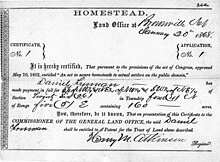Homestead Act
The Homestead Act ( German also Heimstättengesetz ) is a federal law on land acquisition that came into force in the USA in 1862 , which supplemented the national regulations and created further legal certainty for the squatters .
It allowed anyone over the age of 21 to settle on a hitherto uninhabited piece of land, to mark out and farm a 160 acre (about 64 ha) of land. After a period of five years, the settler then became the owner. That time was cut to six months by paying $ 1.25 per acre of land (a total of $ 200).
The law was signed by President Lincoln on May 20, 1862 .
history
At the end of the 18th century there were still over 2,300,000 km² (570 million acres) available for settlement, but only a very small part of this was agriculturally usable. When the settlement line moved westward to the arid steppes of the Great Plains , the amount of land a settler could claim was increased to 2.6 km² (640 acres).
In 1906 the Forest Homestead Act was passed and finally in 1912 a final extension of the law was passed, which reduced the cultivation period of the claimed land to three years before it could become property of the settlers.
Except for a few isolated pieces of land that were unclaimed until the 1950s , land acquisition based on the Homestead Act was essentially complete by 1910, except in Alaska . The Federal Land Policy and Management Act of 1976 ceased this practice of land allocation to public land. The only exception was Alaska, where land could be acquired under the Homestead Act until 1986.
Homestead memorial
In Beatrice , Nebraska , is the Homestead National Monument of America , a memorial to the memory of the settlers under the Homestead Act. The memorial includes the farm of Daniel Freeman, the first settler under the Homestead Act in Nebraska and possibly the United States.
Takeover in Europe
Originating in America, the homestead movement also established itself in Europe from the end of the 19th century, whereby other aspects played a role in addition to the idea of cheaper and secure land acquisition:
- Creation of real estate that is largely beyond the reach of creditors,
- Promoting the idea of settlement and smallholder farming, and
- Curbing the rural exodus .
Corresponding regulations existed in Romania (1864), Serbia (1873), Austria (1888), France (1894), Switzerland (1907), Belgium (1909) and Germany (1920). In Germany, the homestead movement experienced a decisive boost after the First World War, when the livelihoods of those returning to the war or of widows and orphans had to be secured. On the basis of Art 155 WRV , the Reichsheimstätte Law of May 10, 1920 was passed, with the states remaining leeway for further developments. The Heimstätten Act was in effect until 1993.
In Liechtenstein, Articles 794 to 828 of the Law on Persons and Companies created special regulations for homesteads, which are still in force today.
In the Swiss Civil Code , the Heimstätte institute was abolished on January 1, 2000 after it was hardly ever used.
Web links
Individual evidence
- ^ Meyer's Lexicon. Bibliographisches Institut, Leipzig 1926, vol. 5, column 1311
- ↑ quoted from: Julius von Gierke in " Bürgerliches Recht - Sachrecht " 3 , 1948, § 63 (Die Heimstätte), p. 216.
- ↑ Der Große Brockhaus, FA Brockhaus, Leipzig 1931, Vol. 8, p. 328
- ↑ Brockhaus Encyclopedia. FA Brockhaus, Mannheim 1989, vol. 9, p. 623
